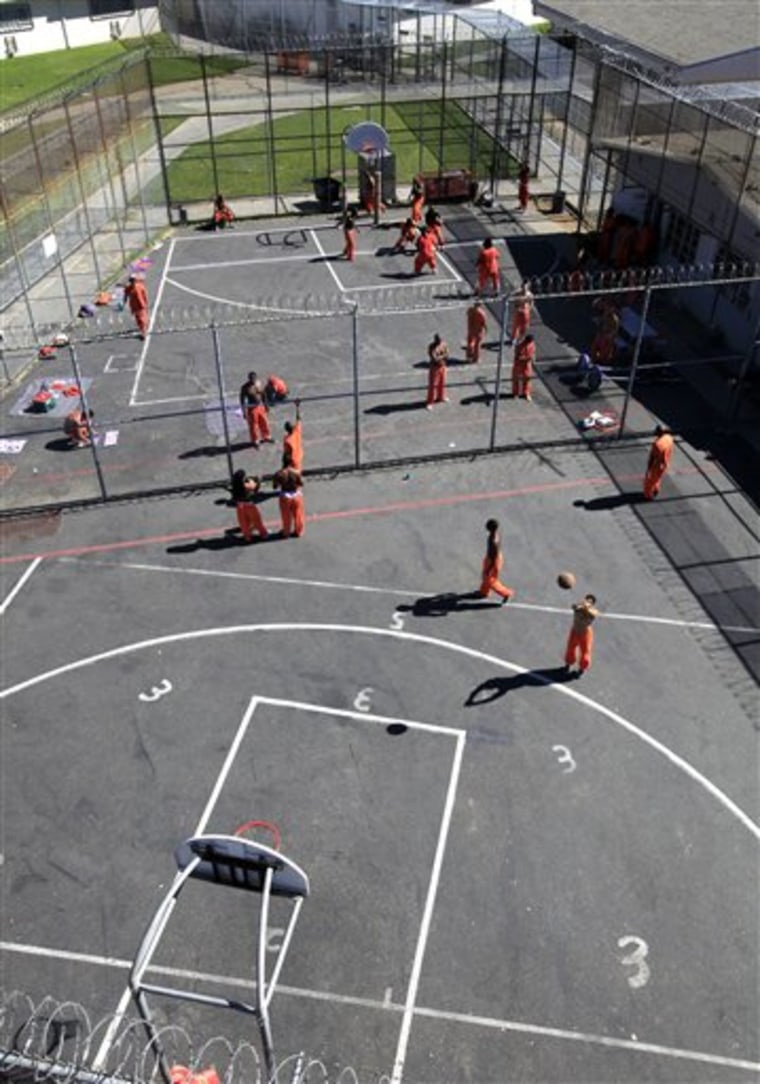California's correctional system is about to undergo an overhaul that could save money and reduce recidivism but also might lead to thousands of criminals spending significantly less time behind bars or in the parole office.
The so-called "prison realignment" beginning Saturday will transfer the state's responsibility for lower-level drug offenders, thieves and other convicts to county jurisdictions.
Some prosecutors and county sheriffs predict rising crime and other dire outcomes from what amounts to the most radical change in the prison system in decades. But others say California's counties can provide better rehabilitation and job training services that can only improve on the state's recidivism record, in which nearly seven of every 10 ex-convicts are returned to state prison after committing a new crime.
The move is designed to reduce the state's corrections costs so more money can go toward public education and other services while also reducing California's prison population to accommodate a federal court order.
"This is a bold vision of a different relationship between the state and local government," Gov. Jerry Brown said Thursday. "It's bold, it's difficult and it will continuously change as we learn from experience. But we can't sit still and let the courts release 30,000 serious prisoners. We have to do something, and this is the most viable plan that I have been able to put together."
Serving in county jail
Realignment means judges will no longer sentence non-violent, lower-level offenders to state prison for crimes such as auto theft, burglary, grand theft, forgery, counterfeiting and drug possession for sale. Instead, nearly 26,000 convicts who would previously have gone to state prison are expected to serve their time in county jails where, proponents say, they will be closer to home, jobs and rehabilitation programs and so will be less likely to commit new crimes after they are released.
The realignment will not affect inmates in state prison today, but rather will apply to those convicted after this week. Those convicted of sex crimes or violent offenses will continue to be sentenced to state prison.
While the length of sentences is to remain the same, jails in many counties are overcrowded and release inmates after they have served a fraction of their time. That dynamic could lead to more inmates being released early, as counties cope with the influx expected to peak over the next four years.
"It's a sea change," said Ventura County District Attorney Gregory Totten, president of the California District Attorneys Association. "That policy of 'Just lock 'em up' is changing."
Critics say counties have neither the money nor the bed space to cope with the coming wave of inmates.
"The law-abiding public is going to pay a huge price as they become the victims of a tremendously spiking crime rate," said Los Angeles County District Attorney Steve Cooley, who attributes years of dropping crime rates throughout California to the many sentencing enhancements available to prosecutors.
"We are abandoning a system that was working," he said.
Los Angeles County Sheriff Lee Baca, who runs the nation's largest jail system, has said he has 4,500 spare beds and is confident he can handle — at least initially — the influx of new inmates. The county expects more than 10,000 extra inmates or people on probation in the first year of the realignment plan.
Sweeping change
Criminal justice experts call California's shift the most sweeping corrections development in the state since lawmakers adopted determinate sentencing in 1977. That change set terms of incarceration by law rather than allowing a parole board to decide on a case-by-case basis when convicts should be released.
California's prison population has exploded over the past two decades as voters and lawmakers approved numerous tough-on-crime measures, including life sentences for those convicted of a third felony and extended sentences for using a gun or belonging to a gang. In almost all cases, voters and lawmakers made the changes without a way to pay for the extra prison space or guards required to house the additional inmates, a scenario that left the state paying more for corrections while it cuts money for higher education, health care and other services.
California's adult prison population has grown from about 97,000 in 1990 to nearly 161,000 today, while the cost of incarceration during that timeframe has risen from $20,562 per inmate to $49,190.

The corrections department now draws $9.8 billion from the state's general fund, or 11.4 percent of this year's spending plan. That is more than the state spends on the University of California and California State University systems combined.
Supporters of the changes say county prosecutors and judges now will have to take into account the financial burden their sentencing decisions create because more criminals will stay in the community for their punishment.
"The Legislature has decided our enthusiasm for incarceration has outstripped our willingness to pay for it," San Diego County Superior Court Judge David Danielsen said.
Once completed, the transfer in responsibility is projected to trim the state's incarceration costs by nearly $1.5 billion. Corrections Secretary Matthew Cate said the savings will come from closing some prisons and laying off correctional and parole officers, although the state will have to be careful to avoid overcrowding the remaining prisons to avoid running afoul of a federal court receiver who is overseeing inmate medical care.
Sentencing lower-level offenders to county jail instead of state prison also is California's primary response to a federal court order, upheld earlier this year by the U.S. Supreme Court, that the state reduce its prison population to improve the medical care given to inmates.
Counties are in line for nearly $1 billion a year to help pay for realignment. The money comes after lawmakers converted part of the state sales tax to a local sales tax. Counties also will receive $453 million from the state's vehicle license fee that used to go to the Department of Motor Vehicles. The DMV is getting part of its money back through a $12 increase in the cost to register a vehicle.
'Destined to failure'
Brown pledged again Thursday that he will put a constitutional amendment before voters in November 2012 to guarantee that local governments get the money no matter if the state runs into more fiscal difficulties. In the meantime, law enforcement authorities differ on whether the realignment will succeed or lead to a crime wave through a mass early release of criminals.
Sacramento County Sheriff Scott Jones predicted the switch "is destined to failure." Jail inmates will serve half their sentences before being released instead of the current two-thirds, and Jones said he cannot open enough jail cells to keep pace with the influx of inmates who previously would have gone to prison.
"You know with certainty there's going to be more people on the street that otherwise would have been in jails or prison," Jones said. "You add to that a statistical certainty of a 70 percent recidivism rate — I don't know how anyone could rightfully argue there's not going to be more crimes in the community."
Others say they are confident the changes will help reduce crime.
Some counties have a head start, and others say they can learn from those successes.
Napa County, for example, created a Community Corrections Service Center in 2009 as it sought alternatives because of jail overcrowding. Dozens of offenders attend classes and undergo regular drug and alcohol testing in a program that can run as long as a year.
Those who succeed can get early release from their jail or probation terms, said Mary Butler, the county's chief probation officer. Of its first graduates last year, 70 percent are employed and less than a quarter have violated their probation or committed new crimes.
In South Los Angeles, officials have converted an old furniture warehouse into what they say is a gleaming example of how probation should be done. Young offenders are given therapy, job training and lessons on how to make wise decisions when posed with a moral predicament. With adequate funding, officials hope to expand the program.
Good intentions aside, counties have had only about six months to prepare for the changes, and some are not ready.
At the Crenshaw probation office in Los Angeles, which will see its current caseload of about 4,000 ex-cons double in the coming year, staffing is the most pressing concern. The county hasn't approved funding for extra probation officers, so existing workers are being placed on an emergency staffing schedule to deal with the strain.
The probation department's senior director, Ed Johnson, said criminals will have fewer check-ins with probation officers and that more medium- and low-risk offenders will be monitored via touch-screen kiosks that ask a set of rote questions.
One of his probation deputies, Larry Holloway, supervises 60 high-risk offenders but expects his caseload to increase to about 200 under realignment.
"I have some concerns about that, for sure," he said.
